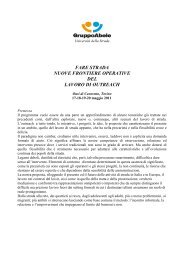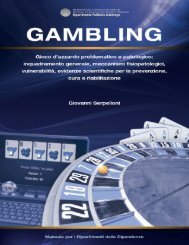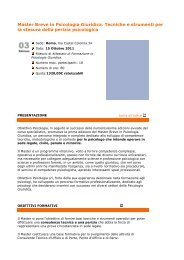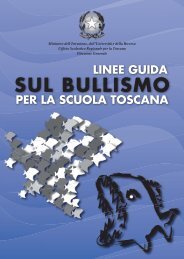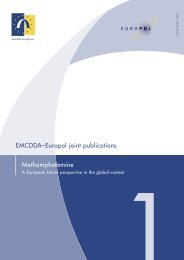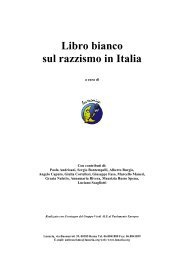Neuroscienze e dipendenze - Dipartimento per le politiche antidroga
Neuroscienze e dipendenze - Dipartimento per le politiche antidroga
Neuroscienze e dipendenze - Dipartimento per le politiche antidroga
You also want an ePaper? Increase the reach of your titles
YUMPU automatically turns print PDFs into web optimized ePapers that Google loves.
280 - E<strong>le</strong>menti di NEUROSCIENZE E DIPENDENZE<br />
possono essere riassunti come segue: definisce lo stato cognitivo<br />
di un individuo e specifica <strong>le</strong> caratteristiche del<strong>le</strong><br />
funzioni cognitive compromesse e/o risparmiate; identifica<br />
la relazione tra <strong>le</strong> misure neuropsicologiche e <strong>le</strong> difficoltà<br />
comportamentali es<strong>per</strong>ite nella vita quotidiana;<br />
fornisce informazioni sullo stato cognitivo dell’individuo<br />
indispensabili al fine di mettere a punto un protocollo di<br />
intervento riabilitativo; contribuisce alla diagnosi medica<br />
nel caso di alcune patologie o alla diagnosi differenzia<strong>le</strong><br />
tra patologie diverse; fornisce e certifica informazioni<br />
sullo stato cognitivo di un individuo con valore a fini <strong>per</strong>itali.<br />
Gli ambiti dell’applicazione della neuropsicologia<br />
sono molteplici, ad esempio in ambito neurologico: la<br />
valutazione neuropsicologica si rende necessarisa <strong>per</strong> l’inquadramento<br />
diagnostico di pazienti con: parkinsonismi,<br />
epi<strong>le</strong>ssie, malattie demielinizzanti, tumori cerebrali<br />
(pre e post intervento chirurgico), traumi encefalici. Particolare<br />
rilievo hanno <strong>le</strong> demenze, <strong>per</strong> <strong>le</strong> quali è sempre<br />
più importante una diagnosi precoce possibi<strong>le</strong>, unicamente,<br />
attraverso la valutazione del<strong>le</strong> funzioni cognitive.<br />
In ambito dell’uso di sostanze: La valutazione neuropsicologica<br />
consente di quantificare i possibili danni<br />
cognitivi conseguenti all’uso protratto di sostanze e sulla<br />
loro base progettare un reinserimento socia<strong>le</strong> e lavorativo<br />
che tenga conto del<strong>le</strong> risorse residue.<br />
In ambito riabilitativo: si valuta l’entità di un danno<br />
conseguente ad un evento vascolare, traumatico o a seguito<br />
di un intervento neurochirurgico, al fine di progettare<br />
e valutare un adeguato protocollo riabilitativo.<br />
In ambito forense: fornisce e certifica informazioni<br />
sullo stato cognitivo di un individuo con valore a fini <strong>per</strong>itali.<br />
In ambito medico/<strong>le</strong>ga<strong>le</strong>: La valutazione può essere<br />
richiesta sia da commissioni deputate al rilascio/rinnovo<br />
del<strong>le</strong> patenti di guida, sia da commissioni deputate al rilascio<br />
dell’invalidità (conseguente ad incidenti sul lavoro,<br />
incidenti stradali, etc.).<br />
SVILUPPO CEREBRALE E DROGHE<br />
Francesco Bricolo<br />
Unità O<strong>per</strong>ativa di <strong>Neuroscienze</strong><br />
<strong>Dipartimento</strong> del<strong>le</strong> Dipendenze<br />
Azienda ULSS 20 - Regione Veneto<br />
Il cervello umano termina la sua maturazione dopo il 20°<br />
anno di vita e maturano prima <strong>le</strong> aree encefaliche più antiche<br />
rispetto al<strong>le</strong> più recenti. Durante l’età evolutiva e<br />
particolarmente durante l’ado<strong>le</strong>scenza il cervello umano<br />
è “sbilanciato”, gl’impulsi limbici non trovano una corteccia<br />
in grado di contrastarli e questo può in parte spiegare<br />
il fatto che durante questo <strong>per</strong>iodo di vita prevalgono<br />
comportamenti impulsivi. La maturazione del cervello segue<br />
la regola dell’usare/<strong>per</strong>dere. I network neuronali che<br />
vengono utilizzati tendono a strutturarsi mentre quelli<br />
che vengono utilizzati meno possono <strong>per</strong>dersi. È compito<br />
del sistema educativo, famiglia, scuola, gruppo dei pari<br />
imparare a fare richieste “attivanti” ed “inibenti”.<br />
NEUROPSYCHOLOGICAL EFFECTS OF CHRONIC<br />
MARIJUANA USE IN ADOLESCENTS AND YOUNG<br />
ADULTS<br />
Krista Lisdahl Medina<br />
University of Cincinnati<br />
Marijuana (MJ) starts during ado<strong>le</strong>scence and peaks in<br />
young adulthood, when the brain is still undergoing critical<br />
neurodevelopment. Therefore, the goal of this presentation<br />
is to characterize the neuropsychological effects of<br />
chronic MJ use during ado<strong>le</strong>scence and young adulthood.<br />
In a series of studies, neuropsychological data were col<strong>le</strong>cted<br />
from MJ using ado<strong>le</strong>scents (ages 16-19) and young<br />
adults (ages 18-28), and non-drug using controls. Thus far,<br />
we have found that even after a month of abstinence, MJ<br />
use during the teen years is associated with poorer <strong>per</strong>formance<br />
on tasks requiring efficient psychomotor speed, comp<strong>le</strong>x<br />
attention, verbal story memory, and planning (Medina<br />
et al., 2007). In these teens, we found significant recovery<br />
of cognitive function after two weeks of abstinence in<br />
immediate verbal memory, but sustained attention continued<br />
to be impaired throughout the month of abstinence.<br />
Our research on young adults (18-28) has shown that increased<br />
past year MJ use was associated with slower psychomotor<br />
speed and sequencing ability, and increased cognitive<br />
inhibition errors. Further, in ma<strong>le</strong> MJ users, increased<br />
MJ use was associated with poorer sustained and<br />
se<strong>le</strong>ctive attention speed and cognitive inhibition.<br />
In summary, our research has shown that both ado<strong>le</strong>scent<br />
and young adult MJ users demonstrate impaired<br />
psychomotor speed, sequencing ability and sustained<br />
and se<strong>le</strong>ctive attention. Evidence of impaired cognitive<br />
inhibition was also seen in both groups. Ado<strong>le</strong>scent MJ<br />
users also had impaired immediate verbal memory and<br />
story memory. Future studies are needed to examine<br />
neural substrates underlying these cognitive deficits and<br />
to determine whether recovery of cognitive functioning<br />
is possib<strong>le</strong> with sustained abstinence.<br />
PSYCHOLOGICAL AND NEUROBIOLOGICAL<br />
MECHANISMS OF RELAPSE AND ULNERABILITY<br />
TO RELAPSE: IMPLICATIONS FOR TREATMENT<br />
Daina Economidou<br />
Department of Ex<strong>per</strong>imental Psychology<br />
University of Cambridge<br />
Relapse to compulsive drug seeking and taking after days<br />
or years of abstinence is characteristic of drug addiction



